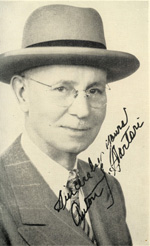Decoration Day - becomes Memorial Day
LeMars Globe-Post
June 11, 1953
(NOTE: We regret that owing to circumstances beyond our control, this column was delayed.)
The little green tents where soldiers sleep and the sunbeams play and the women weep, are covered with flowers today. ~Walt Mason.
-o.p.-
Now properly called Memorial Day, May 30, was formerly known as Decoration Day. It was still being called that when I was a little boy, and I remember it as a day given over to a solemn observance that included a procession to the town’s two cemeteries. During the noon hour, women of the Relief Corps served a dinner in the G.A.R. hall, usually an upstairs room in the downtown section. Veterans of the Civil War, “old soldiers” we called them, made and carried out arrangements for the parade. Weather permitting, a ball game in the afternoon and a bowery dance in the evening provided an outlet for emotions of younger and less serious minded persons.
-o.p.-
Usually credited to the Grand Army of the Republic, observance of a day for the purpose of decorating graves of our soldier dead really had its origin in the South. The custom had its beginning in the Spring of 1862, when women of the South set aside a day to visit graves of soldiers and strew them with flowers. It is further said of these good women—they decorated graves of friend and foe alike. The sweetness of their love and sympathy was not altered by the fact a fallen hero had been sucked into a hellish and unnecessary conflict from north of the Mason-Dixon Line.
-o.p.-
The custom spread and was copied scatteringly and on different days in some northern states due to the seasons. Concerted action came in 1868 when on May 5, Gen. John A. Logan issued his famous order.
-o.p.-
As commander-in-chief of the Grand Army of the Republic, Gen. Logan issued a general order designating May 30, 1868, as a day to be set aside for the purpose of decorating graves of comrades who died in defense of their country during the late rebellion. He did this with the hope that it would be kept up from year to year.
-o.p.-
It is not clear whether Gen. Logan chose May 30 because observances had earlier been held on that day, or whether that date marked the date of discharge of the last Union volunteer of the War. Either way, the plan and style of observance was not original with him nor did wording of his general order mark him possessed of the nobleness of soul displayed by women of the South.
-o.p.-
In 1882, the Grand Army of the Republic urged that the proper designation of May 30 is Memorial Day, not Decoration Day. Since then, the day has taken on a character not in the minds of founders during harrowing days of the Civil War. It now honors the death of all our wars.
-o.p.-
Memorial Day is a legal holiday in all but a few of our states. Some few of the states of the late Confederacy steadfastly refuse to recognize the day. Adoption of the day as a legal holiday has been done by the states singly, there being no national law on the subject.
-o.p.-
In Virginia, the day is observed with reasonable qualifications. They call it Confederate Memorial Day. But we may be sure that in the observance of the day, Virginians also honor the dust of the brave men of the North now hallowing their ground. Into that pool of blood went boys whose mothers to the number of a hundred thousand saw them no more.

